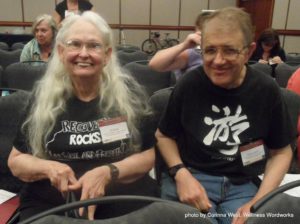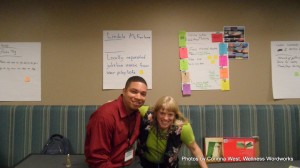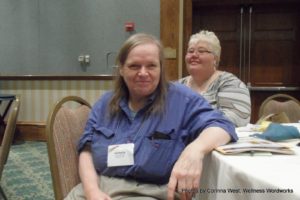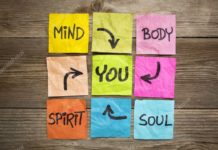Hi, I’m Corinna West, a psychiatric survivor. I was very ill one time and now I’m not. That’s the short story. The slightly longer story is that I have recovered from 12 psychiatric diagnoses, 6 suicide attempts, 5 hospitalizations, 7 shock treatments and 29 medications, up to 6 at a time.
Now I no longer carry a diagnosis or take meds. Now I own my house, my business, a car, and the sweetest brown AND black spotted dalmation mix in Kansas City. Now I ride my bicycle across the Midwest for work trips to places like Omaha, Wichita, and Jefferson City (last week.) I ride across the city to meet homeless guys and visit places most people didn’t know existed, like our double decker train bridge, the concrete canyon blooming beyond with street art, and the worldwide ultraglobal top secret super headquarters.
I’m engaged to be married in May to an awesome guy and I am finally getting the chance to be a parent. This was taken away from me the first time around by my diagnosis. I’m now a regionally recognized artist, have retirement savings, almost no debt, grow much of my own food, and have really awesome friends and hobbies and community connections. As Arlo Guthrie says, “I’m not proud, just tired.”
Tired of seeing my brothers and sisters in recovery dying. Tired of seeing them give up on their dreams. Tired of seeing people get a permanent diagnosis for a temporary problems. And mostly, I’m tired of hearing about the problems without the solutions.

My thought is that if people that were in emotional distress could pay for all of their own treatment, we can eliminate the middleman. We can eliminate the need for long charity funding searches or futile lobbying for government funding when its dominated by institutional recipients. We can create a model with a very minimal need for professional “help” by people with 4-10 years of student loans to pay off. In our business, Wellness Wordworks, peers share factually verified recovery information, inspirational stories, profound artistic statements, challenging exercise opportunities, and engaging community building.
Wellness Wordworks is a type of business called a social entrepreneurship. A social entrepreneurship is a business whose main goal is benefit to our community, not profits. But we have a better chance to solve our problems if we can make enough profit to simply pay for all our own expenses. Then the growth of our business only depends on the demand for the business, and we all can feel deeply and sorely in our hearts the huge unmet need right now for honest mental health information. Here is a description of 12 priniciples of mental health social entrepreneurship and how our program fits those. We would love to hear in the comments below about how your business fits into these 12 principles.
Our Mental health social entrepreneurship uses Google Fiber’s 100 times faster internet:

We were a semi-finalist for $350,000 from Google since we are in Kansas City and figured out a possible way to use the 100 times faster internet that Google is building here. Kansas City was selected as the only city out of 1200 cities to apply for Google Fiber and it’s huge to bring the recovery movement into this project. What can you do with 100 times faster internet? Imagine getting your 40 hour workweek done in 24 minutes. Imagine driving your car across the country not in 7 days but in 1.68 hours. That’s what 100 times faster means. We are on top of something huge, so huge we haven’t even really figured it out. It’s kind of like when Edison invented electricity – no one knew how to use it. What do you do with a light bulb, anyway? And I, personally, don’t even know whether a server in KC means someone gets 100 times faster internet in North Dakota or not.
If you want to help us figure this out, please, please volunteer. Here’s our application form from two months ago when we only had 9 volunteers. The response has been incredible but we still need more help. Currently we have 54 volunteers working on projects like grant writing, medical research, video editing, making surveys, researching software programs, writing blogs for us, going to advocacy meetings, and creating artwork. Our economy is now the gig economy, the new economy, the rise of the creative class with up to 25% of people in the US self-employed. You CAN build your own job, and anyone in the world can help us from anywhere on your own time. When you help us, you gain skills, connections, and approaches for increasing your own income, including with our rapidly expanding programs.
Wellness Wordworks’ mental health social entrepreneurship has two main focus areas:
This will be done by various art programs and research functions. By the way, both the disease model and distress model ARE biochemical models and are evidence based. Remember that looking through medical literature is like reading the Bible. Anything can be taken out of context to support ANY conclusion, but the important thing to look at the overall story.
The distress model looks at science saying emotional suffering causes brain changes after really tough life events, not the other way around. Some studies have shown a 90% correlation between trauma and later development of “mental illness.” The disease model says genetic or chemical brain differences come out of the blue with no relation to life events at all. The overall scientific story is getting weaker and weaker on this one. If the distress model makes more sense for you, please vote for it NOW until March 5 on SAMHSA’s stakeholder forum. Let’s make this the top “behavioral” health story of the year.
And check out our video on the distess model: http://www.youtube.com/watch?v=rootXP-DZl4
Art is the most powerful tool that I, personally, have to spread awareness because it reaches people’s hearts. We use art programs like UnDiagnosing Emotional Distress, Poetry for Personal Power, the Chocolate Fairy, and Create your own Reality to share this idea. Tell me, please, in the comments below, what is your most powerful tool to get the word out? For you, personally? What gives you personal power? [Credit to Pat Deegan for this adaptation of personal medicine]
B: The second focus of our Mental health social entrepreneurship focus is to solve those problems. We are envisioning a website that might be called Connect Power that would be able to fix mental health care for pennies on the dollar. We are also going to expand to all chronic diseases like arthritis, lupus, cancer, diabetes, etc. in reasonably short order. The Connect Power Website will have three main functions:
1)Peer support: people volunteer or get paid by membership fees to help share knowledge with each other via phone text, email, video, online forum, in-person etc. People can make profiles to list what they know, want to learn, and what hours and how they are available. If the video work is done locally it might use the Google Fiber network.
2)Crisis care: people volunteer or get paid to let folks in urgent need of help come over to their house and couch surf for a while. People again put up profiles with what kind of crises they know and can handle, and what kind of space is open in their house. We did a survey of people in recovery to see if they felt like this would work. We got about 100 responses, with roughly 25% saying that guests are not allowed in their house at all due to space or hygiene or landlord issues, about 50% saying people could come over if they were already some kind of friends, and 25% saying that they already bring strangers in crisis into their house. So this is a workable respite care model, with much lower costs.

3) Health care: people can hook up with alternative health care providers and get unlimited group help like exercise, yoga, therapy, or self-improvement classes. If these clases were hosted with video on the web it would again tie in to the Google Fiber network. A higher level of membership fee would included unlimited 1:1 help like therapy, case management, massage, Reiki, or medication advice. This recognizes the huge expense of 1:1 help, especially with people who have degrees and student loans to pay off.
The Connect Power website will be grant funded initially and then paid for by membership fees. If people can’t afford membership fees they can count some of their volunteer time above for the membership fee. We’d like to start by focusing nationally on the peer support part of the website, but the maybe locally in Kansas City market for the crisis care and alternative health care providers. Then later expand nationwide or worldwide. Or maybe you want to do some parallel development in your own town?
So this is my recovery story, and the causes and solutions to emotional distress in 1500 words. Please talk back to me in the comments below. I especially love hearing (politely) from people from whom I DISAGREE because then I keep on learning. And I am still kinda critical sometimes even though I try not to be.















Thank you. I agree that the “full recovery” story is seldom told though it happens pretty regularly. And the “social entrepreneurship” principles are spot on. Good luck with your work.
Report comment
Wow – validating people putting each other up! Safety issues come to mind, but apart from that it sounds brilliant!
I was on a pretty awful peer support course based on a few counselling skills and signposting to other services. The course had been designed by a service provider – it showed. I gave a critique of it to their manager and said that people support each other in all sorts of ways, including putting each other up. So it was exciting to hear that you are promoting this.
I do however have a problem with the idea of social enterprises providing the care that people should get from the state (I’m in the UK and we have the NHS, so insurance is not an issue – though with this present government with it’s privatising agenda who knows where it will go?). Social enterprises can provide some services to some people and maybe show the mainstream services how to do the job better, but I think they will not make huge impacts nationally and internationally. Partly because the funding will still come from central government (or private health insurance – something I know little about, living in the UK it is still mainly state funding, though some services are provided by private providers who bill the state for the service they provide – supported housing is like this and day centres for example) and it is easier for big providers to influence what the funder pays for than for small social enterprises to influence the funders decisions.
It is a bit like food cooperatives and organic food shops are really nice to shop at but they may not have a very big impact on the government food production and distribution policies or big supermarket chain food procurement policies.
So my conclusion is that you have a really exciting flag ship project which is creating a really exciting community (a very big part of recovery is having a supportive community around you) but that there is still a huge need for serious campaigning to change both Government policies and public attitudes to what good mental health care really is.
But good luck with it all and I’ll be checking back in with how your project is progressing!
Report comment
I agree whole heartedly with your call for a shift towards an Emotional Distress model of mental health. It seems to strike at the very heart of our individual needs and our self definition.
Yet while highlighting the foundational needs of an “emotional,” sense of self, your first impulse to proof of recovery is, “Now I own my house, my business, a car.”
Please don’t take this as an attack on your sense of self or your hard won recovery. Its an attempt to point out how we all tend to articulate our experience in this object oriented way? Presumably because its so much easier than defining and articulating our emotional experience, of which at least 80% is unconscious?
Does this point to a profound dilemma, in our overly cognitive sense of self, which seems only able to articulate its experience in “objective” terms? Emotion is not an internal object and perhaps emotional distress is best understood by observing its whole body response in the very young?
During the “terrible two’s,” our core affect/emotion expression begins to be suppressed for the benefit of family & communal harmony. Perhaps one of the ways we adapt & suppress our vital emotional energies, is by taking on an objectified, cognitive sense of self which perverts internal needs and suppresses holistic awareness?
In a wider context, perhaps we have all gone a bit cognitively crazy?
The reaction to two world wars, saw the biggest explosion in mass education, in human history. Yet it came embedded within a centuries old Cartesian clockwork logic, reinforced by the industrial revolution. We still see our brain most commonly depicted in this way, rather than the reality of its organic, electro-chemical nature. Perhaps we collectively moved into an overly cognitive, and objectified sense of self, which has compounded Descarte’s famous error “I think therefore I am.”
“The disease model and distress model ARE biochemical models and are evidence based.”
Neurobiological knowledge is relatively new in human history? As such, we are yet to see a common vocabulary which takes this into awareness, understanding emotion as the electro-chemical activity of our resonant, organic nature?
In defining “The Cause and Solution for Emotional Distress,” do we need to be more specific about what our emotional distress response actually is? Is the cause & effect logic which seems to underpin our cognitive sense of self, stuck in an outdated paradigm of perception? Do we need an educative push towards a common understanding of biochemical complexity, and its role in environmentally triggered, emotional distress?
An example of current research into our complex organic nature;
Fibromyalgia: When Distress Becomes (Un)sympathetic Pain.
The Autonomic Nervous System as a Complex Adaptive System
“Science is an ever changing discipline. The current linear-reductionist medical model appears unable to understand FM and similar maladies. Complexity is a new scientific paradigm that will probably have an impact on the practice of medicine. Complexity originated from the computer’s awesome ability to perform calculations that are far beyond the capability of the human brain. Complexity recognizes that the universe is full of complex systems that work in an apparent disorderly way in an effort to adapt to the changing environment. In these complex systems, the magnitude of the response is not proportional to the intensity of the stimulus, therefore, linear algorithms are futile. Similarly, for complex systems, the whole is different from the sum of its parts, therefore, reductionist approaches are useless. The only way to understand a complex system is with a holistic approach, viewing the system dynamics in its entirety and assessing its adaptation to the environment. Therefore, holism has now scientific basis. Healthy complex systems have disorderly elastic behavior.” http://www.hindawi.com/journals/prt/2012/981565/
The Autonomic Nervous System as a Complex Adaptive System; is also implicated in research into affective disorders, including a whole range of descriptively diagnosed “mental illnesses.” The paradox however is an unconscious “autonomic,” aversion to holding complexity within this peculiar sensation we label mind?
Report comment
Go Corinna!
Your idea is going to be paradigm shifting and world changing. I was SO excited to see you blogging on this site.
I would like to suggest a slight tweak in your description of this model, the addition of a couple of adjectives, namely: the chronic disease model vs. the acute distress model. This is exactly what you’re trying to say, I think. But the addition of the adjectives describes your model more precisely and makes the meaning clearer to others. In medical terms, chronic means perpetual and constant, while acute means the opposite of chronic. Acute also means sharp, extreme, and severe. For example, in describing psychosis, that state of mind can be so overwhelming and frightening, that to call it simply “distress” might be minimizing it too much. Do you get my drift? It’s acute distress, extreme but temporary. Same for major sadness/depression etc. etc.
So, chronic disease vs. acute distress. Whaddaya think?
Report comment